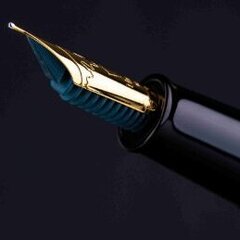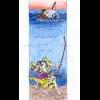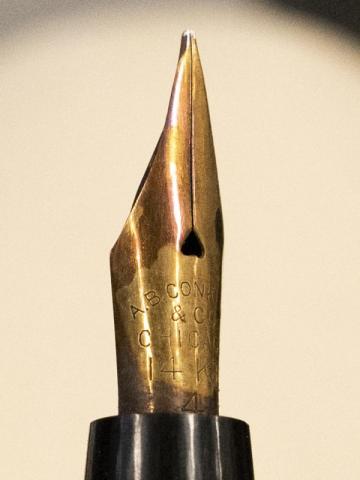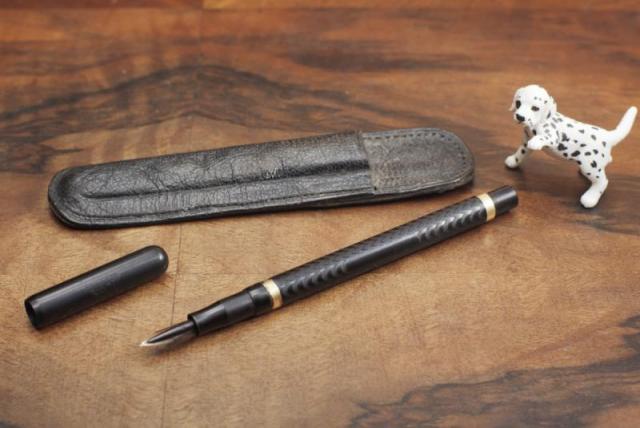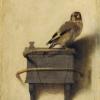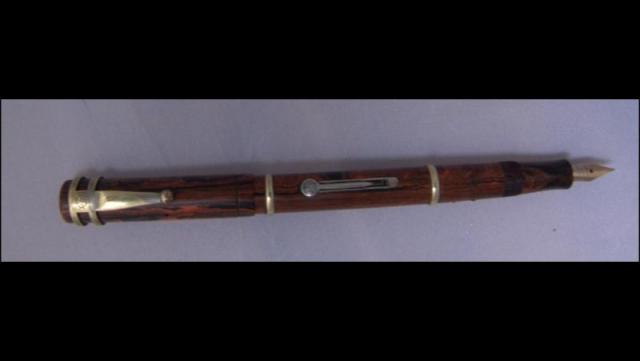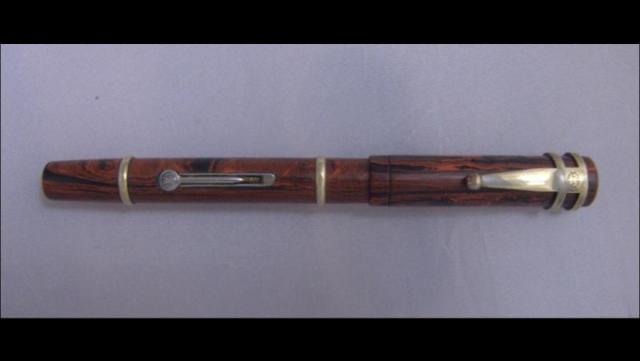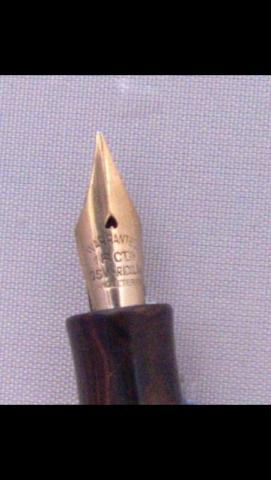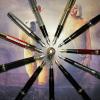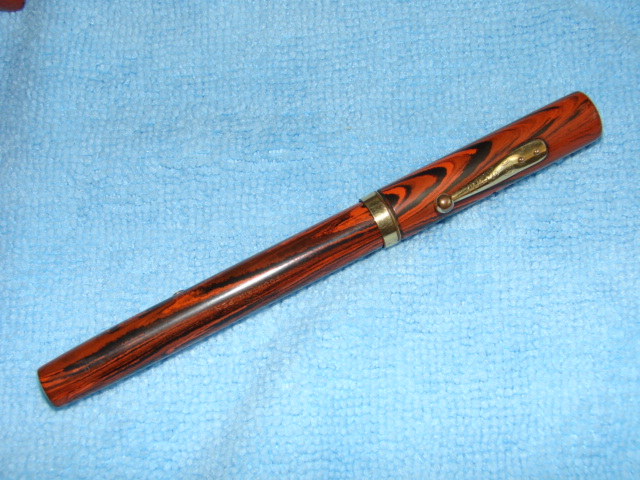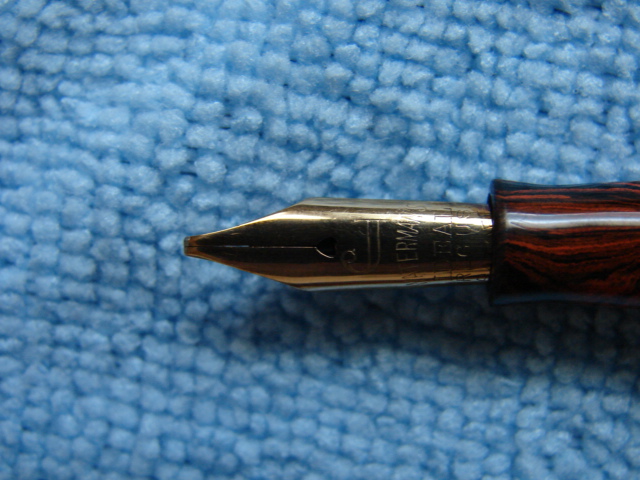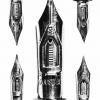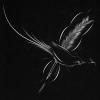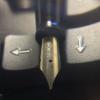Search the Community
Showing results for tags 'hard rubber'.
-
I know this topic has been discussed many many times but I thought I would post an FYI. Recently, for old times sake, I purchased a Waterman #12 (with a B manifold nib of course) to restore just for kicks. It was completely brown with oxidation. I used Novus #2 fine scratch remover and alot of elbow grease to remove the oxidation without removing the Waterman imprint. This will not convert the oxidation, but it will remove it without significantly removing material from the pen. When I was a luthier I used the stuff for the final polish on my french polish (shellac) and lacquer (nitro) guitars. It is also one of the very few scratch removers to work on polycarbonate. Good stuff!
-
On ebonite, something else than silicone grease: are animal fats and beeswax safe?
SimonGuitton posted a topic in Repair Q&A
Hello folks, One of my pleasures in using old pens, is that I can do so without calling on modern industrial activity that is making Earth inhabitable. Second-hand pen, second-hand ink, and I can write without having given a cent of encouragement or means for modern companies to produce more wares at the cost of planet hospitality. And so it would annoy me to have to buy silicone grease for my fpens. I’ve been so far relying on a single gram of the product given to me years ago, to grease my pens, but my “stock” is running out. I am looking for an alternative, ideally a non-industrial one, for the pens I own and will own, which I am resolute for them all to be retractable pens entirely made of ebonite (the why of this is another subject.) I draw your attention on the fact that I am looking for a lubricant/fluid sealant for ebonite only. I know that the generality of lubricating products are harmful to some plastics and celluloid. But what is harmful to those, is not necessarily so to ebonite. Also, I will be only greasing threads that should not be in contact with ink (the cap thread, and the barrel one.) Therefore, the interaction between the alternative lube and plastics, celluloids, sacs, or inks, is not a concern. (It might be if I want to treat the cork seal with it, but I'll think about that later.) I also point out that the point is to lubricate threads, not ensure waterthightness. I think of beef and mutton tallow, pork lard, and beeswax. Tallow is the fat extracted by melting from the fat tissues of oxen or sheep; lard, that from swine. I obtain tallow by buying fat bits of meat from a butcher, dicing these, putting them in a pot in the oven to melt (in the oven, to prevent the bottom from burning, at it happens on stovetops,) letting it melt for a while, then dumping the load in a sieve. Pure fat flows from the sieve, and then, cooling, solidifies. Tallow is preconised on the original labels of callipers for greasing those, and I use it for all rubbing (not spinning) metal parts: threads, articulations, etc. Iron-based metallic materials are not affected by contact with it, while it keeps them from corrosion; and it never stiffens (contrarily to neatsfoot oil, which I used for a while for bearings, until I discovered that that oil, by contact with metal, eventually turned to a honey-coloured and honey-textured mess.) On copper allows though, tallow seems to encourage carbonatation and the formation of greenish stuff. As for beeswax, I suppose everyone is familiar enough with it to spare discoursing on it. I use it to lubricate the sole of my hand-driven wood planes. It too helps carbonatation of copper, it seems. Member Pen Nut suggests it might be a solution. How about on ebonite? Can someone tell me, from experience, if beef or mutton or pork fat, or beeswax, are safe on ebonite, or what it does to it—before I experiment by myself and deliver here the answer which I hoped to find? And, by the way, what did they use, in the olden days, to grease ebonite threads and moving parts (which were not only present in fountain pens, I assume, but sometimes in machinery,) before they had silicone grease?- 14 replies
-
Good Morning, I recently purchased a wonderful Gama Forever fountain pen in a beautiful glossy black finish. One distinguishing factor of this and many other Indian eyedropper pens is the fact that they are made from ebonite, aka vulcanite, aka hard rubber. I am sure that in this forum many are familiar with this material. It is the first time dealing with it for me, personally, so I had this question: Is the gas that Ebonite emits when new or when heated "safe"? I mean "safe" in the sense that it does not pose any detrimental long-term effects to my health. I am aware of the ubiquity of this material in pen manufacturing of yesteryear, so I would think it is! But I just wanted a peace of mind. I look forward to your contributions. Nurmister Edit: I write this due to my recent acquaintance to Volatile Organic Compounds, a set of harmful gases emitted by numerous petroleum-based products. Luckily, I suspect that ebonite does not fall under such a category since: i. Formic acid is used only during the(raw?) rubber manufacturing process. ii. Sulfur is used for vulcanization (but the rubber itself should be desulfurized before further processing, hopefully). iii. Ebonite hates petroleum!
-
Hello everyone, Does anyone have any information about the AB Conklin brand? Though the nib is marked "Chicago," this pen and nib look like they predate the 1938 Chicago acquisition of the Conklin Pen Company of Toledo by quite a few years. I'm quite interested in the story of this pen, because it is in excellent condition, and seems to be a high quality pen with a very flexible nib.
-
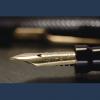
A Swan 3202 Eye Dropper With Stub Nib
SchaumburgSwan posted a topic in Mabie Todd Research/Special Interest Forum/Group
Hi, I've been looking for a second Swan eye dropper and so this one made it's way from England. It is a 3202 MED with stub nib made ca. 1915 to 1920 with an original leather pouch. I think it was good luck to find such a nice pen... Some photos, the Swan as it came, not much to do for restauration, needs some reallignment of the tines. Best wishes Jens- 11 replies
-
Hello! I purchased a Gothic gold Waterman 52 1/2V from Ebay some time back. Upon opening the package, I was greeted with a strong smell similar to paint thinner. I sighed and immediately checked the section and barrel. Sure enough, I saw a clear ring of some sort of sealant between the two. The smell has not dissipated much a few months later, and I am still unsure whether it is the sealant or someone has tried to soak the section in a solvent. The hard rubber still has its black sheen, so it couldn't have been something that would cause it to go dull. After reading a bit on this forum and some other pen restoration websites, I tried carefully heating the barrel with a hairdryer (I am fairly new to fountain pens and do not yet have a heat gun). The section still wouldn't pull out of the barrel. I do not know whether I am not applying enough heat or whether the sealant has a higher melting temp than the hard rubber. Anyone have other ideas for what the sealant could be or what to do? Should I try again with heat and not be so skittish this time? Just send it to a professional?
-
It's been some time since I wrote these first impressions but there's little to add. The Duro remains a delight to behold and to use. I've kept it at home and take it out of its dark cupboard every other night to write a page or two just for the fun of it. It starts without hesitation and keeps on going.
- 6 replies
-
- conway stewart
- cs
-
(and 3 more)
Tagged with:
-
I recently purchased a Parker Duofold Jr from a seller at the flea market. The pen was in good condition. However I did notice that the hard rubber cap had a few thin cracks all over its lip. Is there a way to repair them by chemically welding them or are then any other methods that will give a solution to my problem? Note that the previous owner thought it would be a good idea to super glue the crack which of course didn't work due to the oxidization of the hard rubber. I placed some photos below so you can see the cracks.
- 5 replies
-
- hard rubber
- chemical welding
-
(and 2 more)
Tagged with:
-
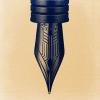
Help Trying To Identify A Vintage Fountain Pen
Zillaxila posted a topic in Fountain & Dip Pens - First Stop
Hello Fountain Pen Community, I recently bought a Vintage Fountain Pen on Ebay. It is a beautiful Ebonite in a Red Ripple pattern. The listing said: The Eric Pen. Made in England circa 1925. Solid 18cts warranted gold nib imprinted Osmi-iridium Anglaterre. As you can see it is a wonderful pen, bought it for 49$ which is a great find for me since I wanted a Red Ripple but the Watermans were too expensive for my budget. Please see the images posted below and if someone can identify better the brand and history of this pen I would be much appreciated. Thanks for the help!- 20 replies
-
- vintage
- red ripple
-
(and 3 more)
Tagged with:
-
Hello everyone. I'm preparing to acquire two pens that I have had my eye on for a long while now and am looking for some help to keep them looking their best. Both are part of Pelikan's 1935 Originals of their Time series, the Jade and Lapiz. I don't intend for these to be display pieces (none of my birds are) but rather regular users. I don't have a lot of experience with vintage materials and want to ensure that the pens stay in as good a condition as they can for as long as they can. My question is, how do you care for celluloid and hard rubber to prevent oxidation and discoloration? I have looked up many threads but most address what happens after hard rubber discolors and the controversy over "re-coloring" it. How do I prevent it in the first place? I find the olive green or brown tint that these pieces take on somewhat unpleasing to the eye. I know to avoid prolonged exposure to UV lighting so definitely keep it out of the sun. Is regular incandescent or fluorescent lighting a problem too with regular use? They will be stored in a chest in a cool, dark place. Just how volatile is the hard rubber? I also understand to avoid contact with hot water as that will cause problems. Anything else you guys can suggest to keep my new birds looking good would be much appreciated. Thanks!
-
Hello all, Today's article at Leadhead's is one which I believe might be of general interest to pen historians. The story begins with a John Holland dip pen/pencil combo bearing an imprint reading "A.G.Day's Pat. Aug. 10 '58." Austin G. Day -- which drew me into researching the scuffling that went on between Day and Nelson Goodyear (as in Goodyear's Patent of 1851) over who was the father of hard rubber. Did Goodyear pull a fast one, as Day alleged in his patent? Yes. But the G. in A.G. Day was for Goodyear -- Austin was Nelson Goodyear's cousin. Did that give Day the inside track and enable him to "borrow" and patent a recipe his cousin had written about? I found something even better . . . conclusive proof that a book written by Goodyear containing the recipe was in Austin G. Day's library. Comments and suggestions welcome. Direct link to the article is http://leadheadpencils.blogspot.com/2016/09/that-third-interesting-holland.html Jon
- 1 reply
-
- hard rubber
- day
-
(and 1 more)
Tagged with:
-
Is alcohol safe for hard rubber? I was looking for a method to clean my hard rubber pens when i find some sources that says it's harmless for this material (unlike for plastic derivatives). It is true? Have someone any experience with this combination?
-
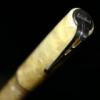
Blackhard Rubber - Preventing The Oxidation? Maybe This Works...
ReNew-Nib-o-holic posted a topic in Repair Q&A
Hi All, Here's a neat question. I just read a thread from 2005 where the late Dr. Donahue stated with his usual scientific eloquence that black hard rubber morphs to "brown" due to "sulpherization." (not his terminology, that's mine of course) Having just bought my wife her first solid sterling flute (she plays fairly well), I read on some flute internet-threads that pros use a product that 3-m makes called 3-M Silver Protective Stips (google them, they're on Amazon). You put the strips of paper right on your cherished solid silver flute in its case. and the paper absorbs sulpher from the air, preventing the flute from tarnishing. The question: Would this same paper product absorb sulpher in the air preventing hard rubber pens from changing from black to brown if the strips were kept in the pen's environment? Appreciate all of those sterling flute-playing pen collectors who chime in All the best, Ellis p.s. Anyone interested in my Esterbrook V-Clip black hard rubber pen? PM me - excellent condition. -
I've spotted what seems a pen in blue/yellow ripple hard rubber. The fact is that, aside the area covered by the cap, the rest of the pen looks more like a olive ripple! Seems the blue part is completely oxidized (i don't know if this is the right term) Now the question: is it possible to restore the original color of that kind of hard rubber?
-
- hr
- hard rubber
-
(and 1 more)
Tagged with:
-
I have a woodgrain Waterman Model 52, which I haven't been using a lot but kept in a pen carrier. I notice that the gold clip has recently fallen off, revealing a glob of what looks a lot like epoxy. Any advice on how these were actually put together, and maybe how to put it back? I still have the clip, btw. Thanks, all.
- 3 replies
-
- waterman 52
- hard rubber
-
(and 2 more)
Tagged with:
-
Hello, I've been doing some research into how people can restore the shine to faded bhr fountain pens and bring out a stronger colour again. Whilst doing my research though, I haven't found anything out about how to restore a fountain pen with a red ripple design, for example. I currently have two Waterman pens in red ripple and in olive ripple which have faded quite badly over the years. Does anybody know a way that these types of hard rubber can be restored? Also, is there a type of wax that can be applied to the surface to prevent fading again? Many thanks in advance,
-
I saw a Waterman's 12 1/2 BCHR on Ebay with what appears to be a Toledo overlay (I have no affilication to seller, see link below). I have never seen any Toledo overlay pen in person and was wondering if this is a genuine example. http://www.ebay.com/itm/131289632586?ssPageName=STRK:MEWNX:IT&_trksid=p3984.m1497.l2649 Item # 131289632586 Thanks, Jesse
- 9 replies
-
- watermans
- toledo overlay
- (and 6 more)
-
I purchased this Waterman's 52 Wood Grain with an unusual #2 "J" nib on Ebay a month or so ago. I may have paid more than I should have but having never run across such a nib, I could not resist. I've only seen one other reference to such a nib on the penboard.de and it indicated that it is a calligraphy nib. Can anyone confirm this or offer additional insight/knowledge about this nib? Regardless of price, it has been a lot fun to write with. Even under the control of my untrained hand, the nib produces excellent ink shading and puts out a really wet line. It is slightly flexible, however pressure predominately enhances the ink flow and not line width. With light pressure, the pen produces a line 1.44 mm in width on the down-stroke!
- 18 replies
-
- calligraphy nib
- watermans
-
(and 2 more)
Tagged with:
-
I figure there are a million "show your pen" threads, so what could one more hurt. Post here and show your Waterman collections, segregated by material, age, era, or however you see. But they do have to be grouped with similar Watermans. Here are my hard rubber and HR-derived Watermans, not counting a 15 PSF and a Paisley pattern 0552½V I received in the mail today. http://imagizer.imageshack.us/v2/xq90/21/lho6.jpg Share yours!
- 5 replies
-
- waterman
- hard rubber
-
(and 4 more)
Tagged with:
-
For your enjoyment... used Instagram's contrast (or whatever the last button on the right does, LOL) feature and it brought out the imprint nicely but it is not this green in real life. The BHR is a nice vintage brown now. http://farm3.staticflickr.com/2840/10041957585_a72fc5e996_o.jpg
- 1 reply
-
- bhr
- hard rubber
-
(and 2 more)
Tagged with:
-
After purchasing some pens, as well as being gifted some, all in the spirit of learning fountain pen repairs, here's my first big question mark! I opened this pen without any trouble and then set out to soak it in water to clean out any ink residue. My first surprise was how the nipple looks eaten up. It's hard to the touch on the outside and the black stuff you see on the paper towel comes from inside. I took that crumbly stuff out of there after approx. 30 minutes of soaking. At first I thought the sac had been glued inside the nipple instead of over, but that black stuff doesn't feel like an ossified sac to me. Lightly brushing my fingers over it on the paper towel is enough to make it crumble further. I left some of the black stuff soak in water overnight and it was still there this morning, so I don't think it's ink either. What could it be then? If I rub my finger hard on the section, it gives off a rubber smell, so my guess is the section is made of hard rubber. What would do this to hard rubber? I tried taking a picture inside the section but I can't make it work. It looks like there's solidified black stuff in there that was gooey at one point in time. Bonus points if you can tell me what pen it is because I have no idea! The only writing I can see is on the lever and it says "MADE IN U.S.A." http://i1282.photobucket.com/albums/a522/TigerLady143/FPN%20Photos/2ef7c2331e61aec49bd79780e5c40478_zps1975df16.jpg http://i1282.photobucket.com/albums/a522/TigerLady143/FPN%20Photos/51be3ce50770280bc1d017ab32714179_zps922361ba.jpg Here I inserted a paper towel to make the irregular edge more visible. http://i1282.photobucket.com/albums/a522/TigerLady143/FPN%20Photos/63200f6d1dc95f024ddf26a0eb7bbb3e_zps386e6956.jpg http://i1282.photobucket.com/albums/a522/TigerLady143/FPN%20Photos/49053f4b34c5edadfbd0d85063a3888d_zps57095f11.jpg http://i1282.photobucket.com/albums/a522/TigerLady143/FPN%20Photos/8957f300141e760d05b3ac3d571a34e6_zps207ca5bf.jpg
- 5 replies
-
- section
- hard rubber
-
(and 1 more)
Tagged with:
-
I've acquired a cute little Salz Brothers Peter Pan, which is approximately two and a half inches long, capped. It needs a new sac - which is not surprising - but thus far I've been unable to get the section out in order to replace it. Doesn't budge at all. Here's some snaps: http://sudowned.com/filebox/pens/peterpan/1.JPG http://sudowned.com/filebox/pens/peterpan/2.jpg I haven't soaked it as that murders hard rubber sometimes. I may soak it gently - just the section and seam - and perhaps in ink, but what I really need to know is whether the section is threaded or friction-fit. At least if I know that, I won't be pulling it in an inherently dangerous way when I add (gentle, distant) heat to the mix.

